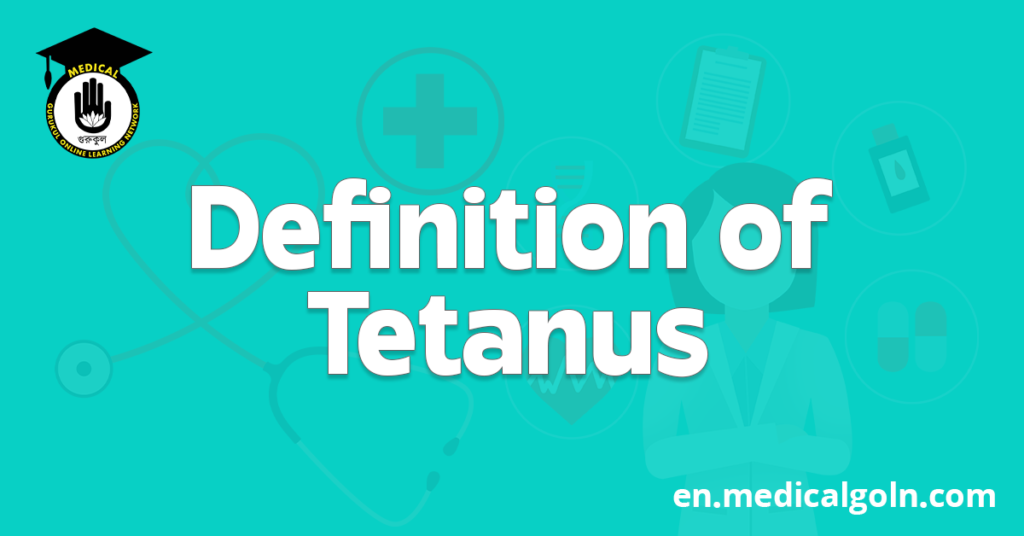Today is our topic of discussion Definition of Tetanus
Definition of Tetanus
Definition:
An acute disease induced by the exotoxin of clostridium tetani clinically characterized by muscular rigidity punctuated by painful paroxysmal spasms of the voluntary muscles.
Agent factors:
Agent:
clostridium tetani (Gram positive, spore-bearing & anaerobic bacteria)
Reservoir of infection:
Soil, intestine of herbivorous animals (e.g., cattle, goats, ship) & human
Exotoxin:
Tetanospasmin and tetanolysisn affecting nervous system.
Period of communicability:
None. Not transmitted from person to person.
Host factors:
Age:
It is a disease of active age.
Sex:
Males predominantly affected than females.
Occupation:
Agricultural workers mostly affected.
Rural urban differences:
Incidence is much lower in urban than in rural areas.
Immunity:
No age is immune unless protected by immunization.
Environmental and social factors:
1. Unhygienic customs and habits
2. Unhygienic delivery practices
3. Ignorance about infection and lack of primary care services
Mode of transmission:
Contamination of wounds with tetanus spores followed by germination and elaboration of exotoxin and binding to the receptor.
Incubation period:
6 to 10 days
Pathophysiology of tetanus:
C. tetani produces tetanospasmin, a powerful neurotoxin, binds irreversibly to neurons, travels to CNS through peripheral nerves. The toxin does not affect cognitive processes.
Types of tetanus:
Traumatic:
Trauma is the major and important cause of tetanus
Puerperal:
Tetanus follows abortion more frequently than a normal labour
Otogenic:
Foreign bodies in the ear may introduce the infection.
Idiopathic:
In these cases there is no definite history of sustaining an injury.
Tetanus neonatorum:
The common cause is infection of the umbilical stump. The first symptom is seen about the 7th day after birth. It is also associated with unhygienic delivery practices.
Risk factors for tetanus:
1. Inadequate immunization
2. Neonate born to unimmunized mother
3. Elderly with declining immune status
4. Injection drug use
5. Chronic wounds
6. Acute traumatic injury
7. Unhygienic delivery conditions and practice of applying mud or feces to umbilical cord
Clinical features:
Prodromal stage:
1. Difficulty in swallowing
2. Pain in the neck, back and abdomen
3. Wound pain
Stage of tonic rigidity:
1. Lockjaw (Trismus or spasm of the muscles of mastication)
2. Opisthotonus (Muscles in the abdomen, back, neck, and face go into spasm)
3. Risus sardonicus (Spasm of the muscles at the angle of the mouth)
Stage of clonic spasm:
1. Laryngeal and pharyngeal spasm
2. If the infection is severe, convulsions are set off by slight disturbances, such as noises and light. During convulsions, there is difficulty in breathing and the possibility of asphyxiation.
Treatment:
General measures:
1. Keep patient in a quiet, darkened room with minimum stimulus.
2. Monitor cardiac and respiratory status closely.
3. Tracheostomy (if required) to prevent fatal laryngospasm.
4. Monitor and treat urinary retention and constipation.
5. Skin care
6. Parenteral nutrition is usually required to maintain adequate nutrition and hydration.
7. Monitor for and correct electrolyte abnormalities, especially hyperkalemia.
Specific measures:
1. Human TIG: 3000-6,000 U IM. Part of the dose may be infiltrated around the wound. In neonatal tetanus – 500 U IM.
2. Tetanus toxoid administered IM at a site contralateral to where TIG is given.
3. Penicillin G: 100,000-200,000 U/kg/d IV in 4-6 divided doses.
4. Metronidazole 400-800 mg 8 hourly for 7 days or erythromycin, if allergic to penicillin.
5. Sedation and muscle relaxation: Diazepam 0.1-0.2 mg/kg IV q4-6h.
Prevention of tetanus:
A. Active management of tetanus-prone wound (by following the algorithm given below).
B. Active immunization: 1. Combined vaccine in children: DPT &/ pentavalent.
2. Tetanus Toxoid for women of child bearing age.
3. Tetanus Toxoid prophylaxis for others: 3 doses (first day, after 1 month & 6 months followed by yearly booster for 2 years)
C. Passive immunization: TIG D. Antibiotic prophylaxis (Given above)
Additional prophylaxis means ‘TIG’.
See also :

